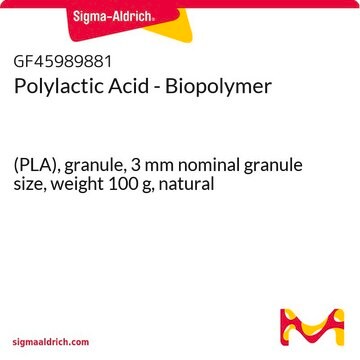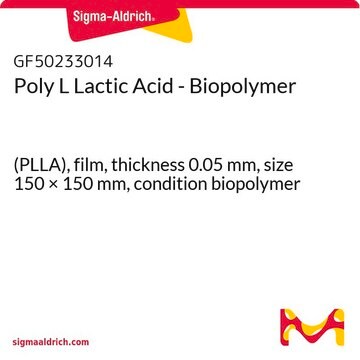38534
Polymilchsäure
Mw ~60,000
Synonym(e):
Poly-(2-hydroxy-propionsäure)
About This Item
Empfohlene Produkte
Form
solid
Haltbarkeit
limited shelf life, expiry date on the label
Mol-Gew.
Mn ~30,000
Mw ~60,000
InChI
1S/C3H6O3/c1-2(4)3(5)6/h2,4H,1H3,(H,5,6)
InChIKey
JVTAAEKCZFNVCJ-UHFFFAOYSA-N
Suchen Sie nach ähnlichen Produkten? Aufrufen Leitfaden zum Produktvergleich
Verwandte Kategorien
Allgemeine Beschreibung
Anwendung
It can be used to prepare PLA/polyvinyl alcohol wound dressing membrane through electrospinning and coating method. The coating of PLA improves the mechanical strength of nanofiber and acts as a protective layer to control the release of drug to the wound site.
It can also be used to synthesize free-standing, flexible ultra-thin PLA nanofilms which can act as a matrix for adhesion, spreading, and proliferation of skeletal muscle cells.
Leistungsmerkmale und Vorteile
- Biocompatibility
- Lower toxicity
- Low cost
- Better encapsulation
Ähnliches Produkt
Lagerklassenschlüssel
11 - Combustible Solids
WGK
WGK 3
Flammpunkt (°F)
Not applicable
Flammpunkt (°C)
Not applicable
Persönliche Schutzausrüstung
Eyeshields, Gloves, type N95 (US)
Analysenzertifikate (COA)
Suchen Sie nach Analysenzertifikate (COA), indem Sie die Lot-/Chargennummer des Produkts eingeben. Lot- und Chargennummern sind auf dem Produktetikett hinter den Wörtern ‘Lot’ oder ‘Batch’ (Lot oder Charge) zu finden.
Besitzen Sie dieses Produkt bereits?
In der Dokumentenbibliothek finden Sie die Dokumentation zu den Produkten, die Sie kürzlich erworben haben.
Kunden haben sich ebenfalls angesehen
Artikel
Electrospinning technique applications discussed, emphasizing control of nanofibers and assembly into 3D architectures.
Unser Team von Wissenschaftlern verfügt über Erfahrung in allen Forschungsbereichen einschließlich Life Science, Materialwissenschaften, chemischer Synthese, Chromatographie, Analytik und vielen mehr..
Setzen Sie sich mit dem technischen Dienst in Verbindung.









